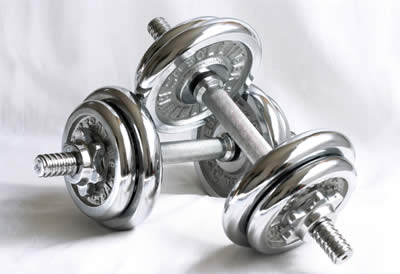
Back in those days when I was exercising regularly (which seems a long time ago), I have always included strength training with machine weights, dumbbells and barbells in my exercise routine. Some people don't like lifting weights. Many people have misconceptions about strength training. That's why they avoid doing it. They presume strength training is just for bodybuilders. Here are some of the misconceptions:
- Strength training bulks you up so that women will look masculine if they do it. Unless you are on anabolic steroid, it won't make you bulky.
- No pain, no gain. Strength training hurts. If you experience more than a little soreness after strength training, check your technique.
- Strength training is for spot reduction e.g sit ups for flatter stomach. No such thing! You have to burn the fat surrounding the muscles to get a flat stomach.
- Strength training doesn't help in weight loss. More muscle means higher resting metabolic rate. Muscle is like a furnace which helps you burn more fat and lose weight more easily.
- Children shouldn't do strength training. Age-appropriate strength training will helps children develop strong muscles and bones.
- Old people can't do strength training. It actually helps maintain muscle strength and bone density. It also helps to maintain balance.
- You must be fit to do strength training. You can begin strength training even if you are not aerobically fit. Aerobic and strength training are part of a complete fitness program.
- You need special equipment to do strength training. You need some form of resistance to do strength
training. You can still do push ups, sit ups, squats or lunges using your body weight as resistance. Free weights, dumbbells and resistance rubber bands are cheap, affordable resistance equipment.
What's the most effective ways to do strength training?
- Sessions: Experts recommend three training sessions per week for beginners. A session should last 20 minutes to one hour, which include time for warm up and cool down. You should rest a day between workouts to allow for muscle recovery. Each session should target 2 to 3 muscle groups.
- Warm up & cool down: You should do 5-10 minutes warm up with aerobic exercise before lifting weights. After you finished the session, you should stretch your body to prevent injuries and improve flexibility.
- Number of repetitions: What is your objective? If you want to tone up and increase muscle strength, go for higher number of reps (12-15) with lighter weights. This will also boost your endurance. If you want to build muscle mass, go for lower reps (4-8) with heavier weights.
- Focus on form: Concentrate on perfecting your form. Avoid arching your back and rocking to gain momentum. Use proper breathing technique. Exhale through your mouth when lifting, inhale through your nose when lowering weight. Avoid breath holding. Use the full, natural range of motion when lifting weights. Avoid going past your body's natural limits to prevent injuries.
Everybody should include strength training in the exercise routine. To sum up, the health benefits are:
- Increased muscle strength and tone.
- Better flexibility, posture and balance.
- Increased resting metabolic rate.
- Increased bone density.
- Improved self-confidence, which is the pièce de résistance!
No comments:
Post a Comment